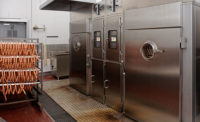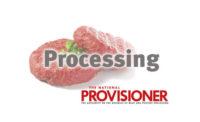
Photo courtesy of Fristam Pumps USA
Pumps, motors and drives are the workhorses of the processing plant. Without them, machines simply couldn’t operate.
Pump technology must be able to gently pump solids, without the animal product becoming damaged. The food-processing industry currently uses different pump designs such as gear, diaphragm, centrifugal, electric and air-operated double diaphragm pumps. It’s just a matter of finding the correct pump for the right application.
Air-operated pumps are becoming popular because they use compressed air instead of electricity and can operate in areas where other pumps may fail or have problems.
Their larger passageways also allow for bigger pieces of product to easily move through to the appropriate container. The key is to keep the diaphragm from rupturing due to any foreign materials. Dakota Turkey Growers, based in Huron, S.D., uses air-operated and diaphragm pumps with its turkey meat.
“They pump a good volume, handle the solids going through them well and are pretty simple to use,” says Tom Shields, plant engineer, Dakota Turkey Growers. He notes that because there are no motors involved in the application they require little maintenance.
“The only issue we’ve had with them is undersizing them for the objects we’re pumping through, which is our fault because we sized them on our own,” he says.
Motors have also seen improvements such as the mounting of air-pressure systems in a wet environment, double dipping of the motor windings for an extended motor life and utilizing the servo motors and encoders to allow for repeatable lift points, says Jeff Evers, senior maintenance manager, Butterball LLC, based in Mt. Olive, N.C.
When installing the encoders, systems can be programmed to give the same repeatable lift or stop points through the use of programmable logic controller (PLC) processors.
In the past, 110 AC motors were largely used but aren’t any longer due to the safety hazard associated with their voltage.
“The stainless-steel side of motors and drives has been addressing food safety more in recent years with the development of inner core drive type motors and sealed bearing systems all in one application,” says Evers, noting the seals need to be able to withstand the daily high-pressure washdown applications during the sanitation process.
According to Evers, Butterball ensures proper maintenance of is equipment by first verifying and recording the amperage (the strength of an electric current) frequency when the unit is being installed, which will pre-determine the life of the system; enlisting outside sources to document and send monthly data for entry into its computerized maintenance management system (CMMS) regarding the infrared scanning for bearing wear and the internal heat of the motors; and choosing the correct specified motor for an application to yield an increased product life cycle.
Drives are also seeing improvements with manufacturers now placing them inside machines on the inside of the rollers, providing additional protection against rotating parts and contamination, and saving about 20 inches of space in the process.
Pumps, motors and drives may have not changed too dramatically in the past 30 years, but processors’ requests are always the same.
“We’re always trying to be more efficient, extend the life of the machine and require less maintenance on our pumps and drives,” says Mike Wolf, maintenance engineer, Sioux-Preme Packing Co., based in Sioux City, Iowa.






